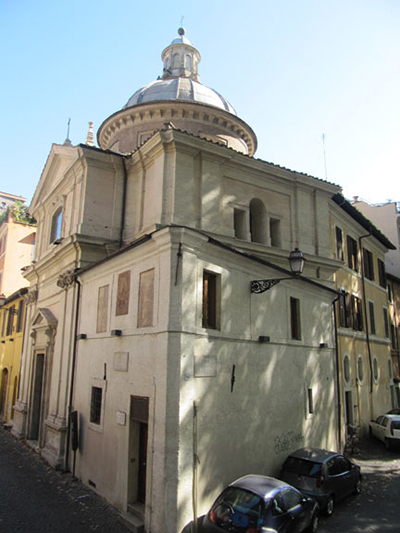Sant'Eligio degli Orefici by Raphael is a church located in Rome. Raffaello Sanzio popularly known as Raphael did its initial design and works.
He was a painter and architect whose works still rank as amongst the best in the world. While designing this building, Raphael went for grandeur, beauty and perfection. Up to this day, the building is a tourist site as its pillars, and architectural designs are a thing of wonder. Raphael's love for Geometry and Math played a vital role in the designing of the Sant'Eligio degli Orefici. The building is a perfect combination of math and symmetry, showcasing Raphael's mastery of technical and architectural analysis. The edges of the building are multidimensional giving a viewer an ideal glimpse of its magnificence from any angle.
The dome and drum used for this building are typical of Raphael's style of architecture. There are pendentives and crossing points in the buildings inner and outer structure that displays architectural magnificence. He used oriental marbles and granite for the outer layer of the building to give it the classical renaissance look. The structure actively engages a person with attention to visual apprehension. Its exterior is a complex mix of architectural membering that relies on shade and light. On the lower level of the building, Raphael went for a radial transverse of the vaults. On the upper-level, he designed the pilasters to fold round the angles of the polygon. It has a three-dimensional presence with a concave arrangement. The Sant’ Eligio degli Orefici also has round arches and carved portals as per Raphael's design.
Baldassare Peruzzi was another architect involved in the construction of this building. He had worked on numerous projects with Raphael and continued with the Sant' Eligio degli Orefici even after the latter’s death. He mostly worked on the interior of the building and the roofing. The hall of the building gets attributed to him. It is a simple but artistic arrangement of pilasters. All the architects involved in the designing of this building were painters, and their influence on the church are still visible to date.
Bastiano da Sangallo was another architect who took part in the Sant'Eligio degli Orefici. He was a skilled sculptor and painter and was nicknamed Aristotle for his air of sententious gravity. He was involved in the sculpting and painting of the building. Donato Bramante was also involved in the construction of the building and was heavily involved in its art.
Raphael main contrast from legends such as Michelangelo and da Vinci is he always completed his designs. Other than his surroundings, Raphael also got influenced by other artists of his time. He would borrow an idea from other artists and proceed to come up with a design that reflected his personality. His paintings showcase high energy and the figures that are part of it are harmonious and calm. All his paintings and designs are balanced although at times exaggerated giving it an artistic illusion.
Raphael would also experiment with chalk and led which gave his sketches more detail. In comparison to other artist’s works, Raphael's had more depth that allowed him to plan his designs and paintings. The paintings he did showed different variants and positioning which would play a part in the telling of the narrative of the art. His technique at the time was unique to him, which enabled people to tell them apart from other painters and architects of his time. Although Raphael died before the completion of the Sant’Eligio degli Orefici, the building's design and architecture widely get attributed to him. At his time he was mostly overlooked as an artist but would play an integral part in Italy's architectural renaissance. Today the church is a significant tourist attraction and symbol that reflects the brilliance and architectural genius of Raphael and his partners.




